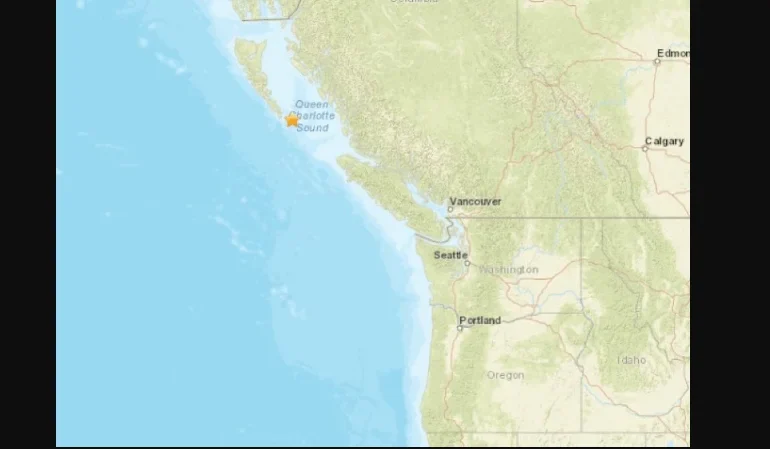
formidable earthquake struck off the Pacific coast of Canada, causing significant tremors across the region
On the morning of Thursday, a formidable earthquake struck off the Pacific coast of Canada, causing significant tremors across the region. The initial quake, registered at a magnitude of 6.6 by the U.S. Geological Survey (USGS), was a notable seismic event that rattled communities and infrastructure alike. The quake’s epicenter was located near the Haida Gwaii archipelago, a remote and sparsely populated region off the coast of British Columbia. Despite the relatively remote location of the epicenter, the effects of the earthquake were felt widely across the Pacific Northwest, underscoring the potent force of tectonic activity in this geologically active area.
As the earthquake’s tremors rippled through the region, residents of British Columbia experienced a brief but unsettling period of shaking. In cities such as Vancouver and Victoria, the shaking was described by locals as a rolling motion that lasted several seconds. The sensation was powerful enough to disrupt daily activities and prompt concern among residents, many of whom took to social media to share their experiences and seek reassurance. The earthquake’s impact was felt across a broad geographic area, demonstrating the extensive reach of seismic waves generated by such a significant event.
In response to the earthquake, the National Tsunami Warning Center issued a tsunami warning for the entire West Coast of North America, spanning from California to Alaska. This precautionary measure was a standard protocol given the quake’s magnitude and the potential for seismic activity to generate dangerous tsunami waves. The warning reflected the heightened state of alert and preparedness among emergency services and coastal communities. However, as the hours passed and further assessments were conducted, the National Tsunami Warning Center later revised their assessment, stating that no tsunami was expected. This announcement was a relief to residents and authorities alike, who had braced for the possibility of substantial coastal flooding.
The decision to issue and then retract the tsunami warning highlights the complexities involved in tsunami prediction and response. Seismologists and meteorologists must quickly analyze seismic data and oceanographic conditions to determine the potential for tsunami generation. The process involves evaluating the quake’s depth, magnitude, and impact on the seafloor. The absence of a tsunami ultimately reflected the quake’s characteristics and the broader oceanic conditions at the time, demonstrating the effectiveness of modern monitoring systems in mitigating the impact of such natural disasters.
Despite the absence of a tsunami, the earthquake prompted a flurry of activity among emergency responders and local authorities. Preparations were made for potential evacuations, and emergency services were put on high alert. In affected communities, building inspections and safety checks were carried out to ensure that structures remained intact and that no hidden damage posed a risk to residents. The swift response underscored the importance of readiness and resilience in the face of natural hazards, particularly in a region known for its seismic activity.
Reports of damage and injuries following the earthquake were initially scarce, with no immediate major damage being reported. This was a fortunate outcome, given the quake’s magnitude and the potential for serious consequences. However, as is often the case with earthquakes, smaller aftershocks and secondary effects could still pose risks in the days and weeks following the initial event. Authorities and residents alike remained vigilant, ready to address any emerging issues that could arise as a result of the seismic activity.
The earthquake’s impact on local infrastructure and daily life was significant but manageable. In the aftermath of the quake, residents reported various minor disruptions, such as power outages and disruptions to transportation services. Businesses and schools temporarily closed or adjusted their operations as a precautionary measure. The earthquake served as a reminder of the importance of preparedness and the need for robust emergency plans to mitigate the effects of such events on communities and services.
In the broader context of seismic activity in the Pacific Northwest, this earthquake is part of an ongoing pattern of tectonic activity in the region. The Pacific Ring of Fire, an area known for its high level of volcanic and seismic activity, encompasses this region and is a constant reminder of the dynamic nature of Earth’s geology. The interactions between the Pacific Plate and the North American Plate contribute to frequent seismic events, making earthquake preparedness a critical component of life in this region.
This earthquake also serves as an opportunity for reflection on the advancements in seismic monitoring and emergency response. The ability to rapidly detect and assess earthquakes, issue warnings, and evaluate potential threats such as tsunamis is a testament to the progress made in understanding and managing natural disasters. The collaboration between various agencies, including the USGS and the National Tsunami Warning Center, demonstrates the effectiveness of coordinated efforts in safeguarding communities from the impacts of seismic events.
Looking ahead, the earthquake will likely prompt further analysis and review of emergency response protocols and building safety standards in the affected areas. Lessons learned from this event can inform future preparedness efforts and enhance resilience against similar natural disasters. The ability to learn from and adapt to such events is crucial in minimizing their impact and ensuring that communities are well-prepared for future seismic activity.
In summary, the powerful earthquake off the Pacific coast of Canada was a significant seismic event with wide-ranging effects. While the initial quake prompted a tsunami warning that was later rescinded, the overall response demonstrated the effectiveness of modern monitoring systems and emergency preparedness. The event highlighted the need for ongoing vigilance and readiness in a region known for its seismic activity, and it underscored the importance of learning from such events to enhance future resilience.



